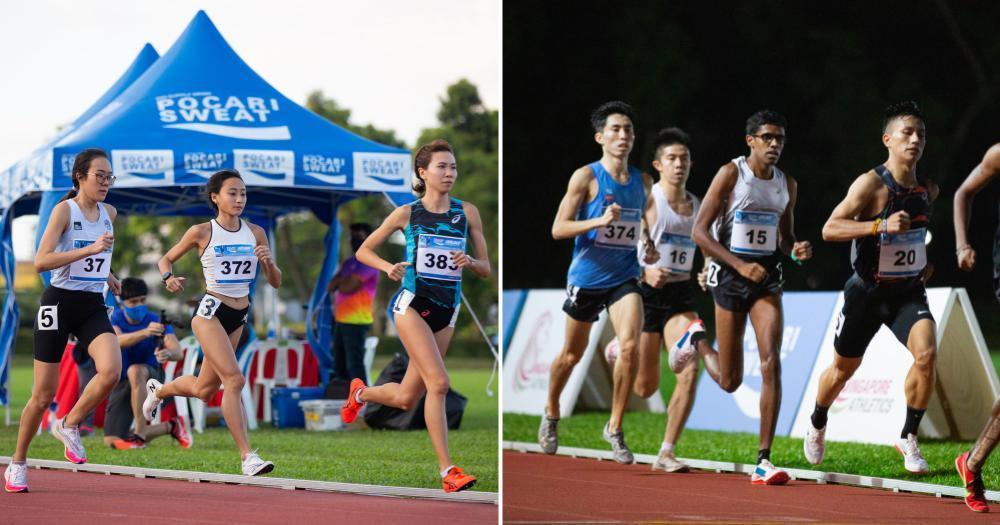Here’s a saying about the 2.4km run that some NSmen may have heard once or twice: The 2.4km distance was selected for Singapore’s Individual Physical Proficiency Test (IPPT) because of the length of the causeway.
Obviously, it’s not true, given that the causeway is just over 1km long.
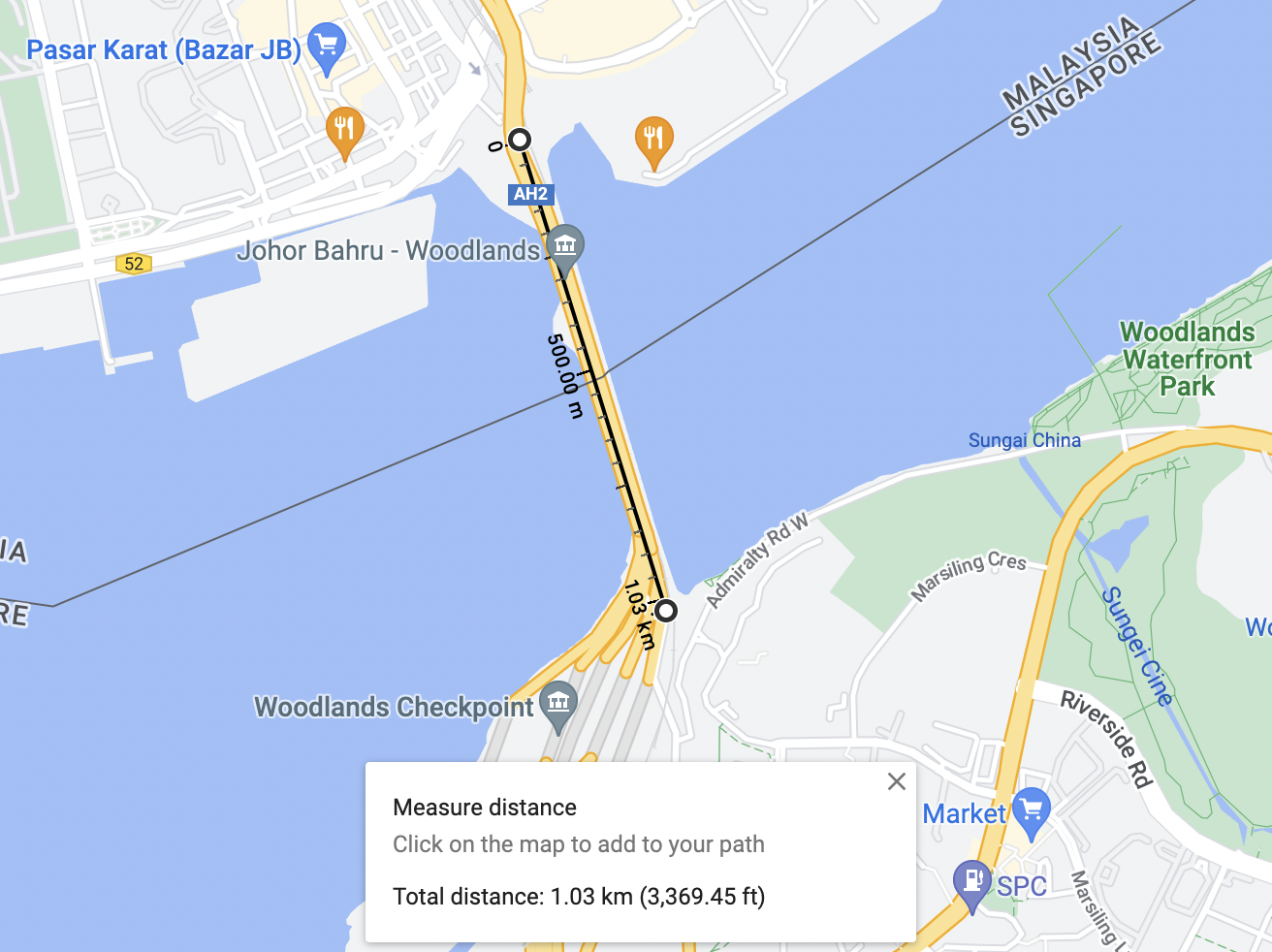 IPPT and NAPFA test would be much easier if the running distance was based on the causeway’s length. Screenshot via Google Maps.
IPPT and NAPFA test would be much easier if the running distance was based on the causeway’s length. Screenshot via Google Maps.
Furthermore, the 2.4km run is one that many militaries — not just Singapore’s — use as a test of fitness because it’s a distance that requires both aerobic and anaerobic endurance (more on that later).
Both young men and young women are introduced to the 2.4km distance in schools as part of the National Physical Fitness Award (NAPFA) scheme.
But like the causeway rumour, misconceptions about the run and how to train for it are still fairly common.
Who better to address some of these misconceptions than Singapore’s fastest 2.4km runners, Jeevaneesh Soundararajah and Goh Chui Ling, who clocked blistering fast paces of 6m 52.97s and 7m 58.50s at the Pocari Sweat Run 2021.
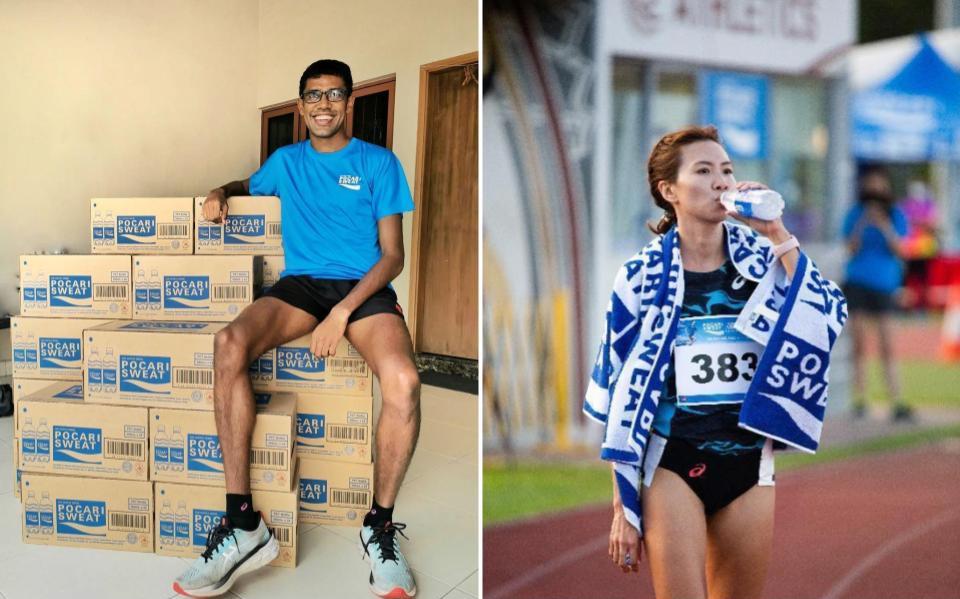 Jeevaneesh Soundararajah and Goh Chui Ling — Singapore’s fastest 2.4km runners. Photo via Pocari Sweat Singapore.
Jeevaneesh Soundararajah and Goh Chui Ling — Singapore’s fastest 2.4km runners. Photo via Pocari Sweat Singapore.
1. “2.4km is short enough that it’s all in the mind. You don’t need to train that much.”
You might have heard this from a well-meaning friend trying to push you to a better timing.
However, both athletes agree that there’s a very real physical aspect to the 2.4km run that you can’t get away from.
“If you’re intending to go faster, then it’s about getting uncomfortable and doing the hard work,” says Goh. “It's really not all mental because it comes with training, both physical and mental.”
“You definitely need to train physically as well,” says Jeevaneesh.
“Running is both physical and mental… I mean the mind can keep you focused… but I think the action is the one that counts lah. The mental push is good, but you need that physical effort.”
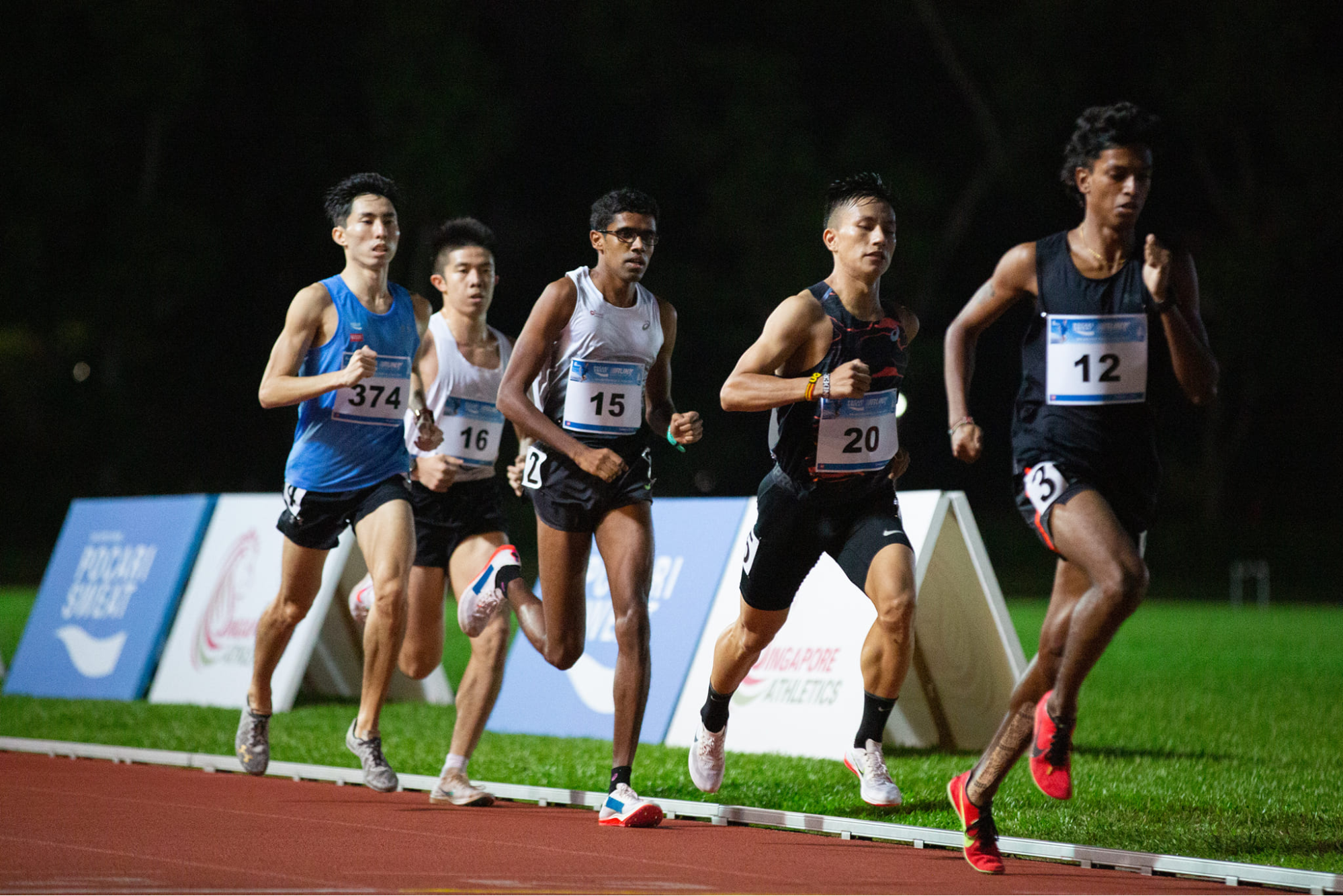 Jeevaneesh (with the #15 race tag) on his way to setting the men’s national best time for 2.4km at the Pocari Sweat Run 2021. Photo via Pocari Sweat Singapore.
Jeevaneesh (with the #15 race tag) on his way to setting the men’s national best time for 2.4km at the Pocari Sweat Run 2021. Photo via Pocari Sweat Singapore.
2. “To train for 2.4km, just keep running 2.4km.”
To those training for a 2.4km, Goh says unequivocally: “I would not suggest doing a 2.4km.”
“If you're trying to get into an ideal race strategy for 2.4km, you would be absolutely exhausted after 2.4km. Because if you're not absolutely exhausted, your race strategy is too easy for you. So you don’t ever want to reach that level of fatigue at training.”
It might surprise you that Goh’s blazing fast sub-8-minute 2.4km timing at the Pocari Sweat Run 2021 was her first 2.4km run since her time in junior college.
Of course, this was all part of her race strategy.
“Mentally, you don’t want to know where you stand until you finish your training cycle,” she says.
Instead, her advice is to limit one’s timed runs to 2km, at most.
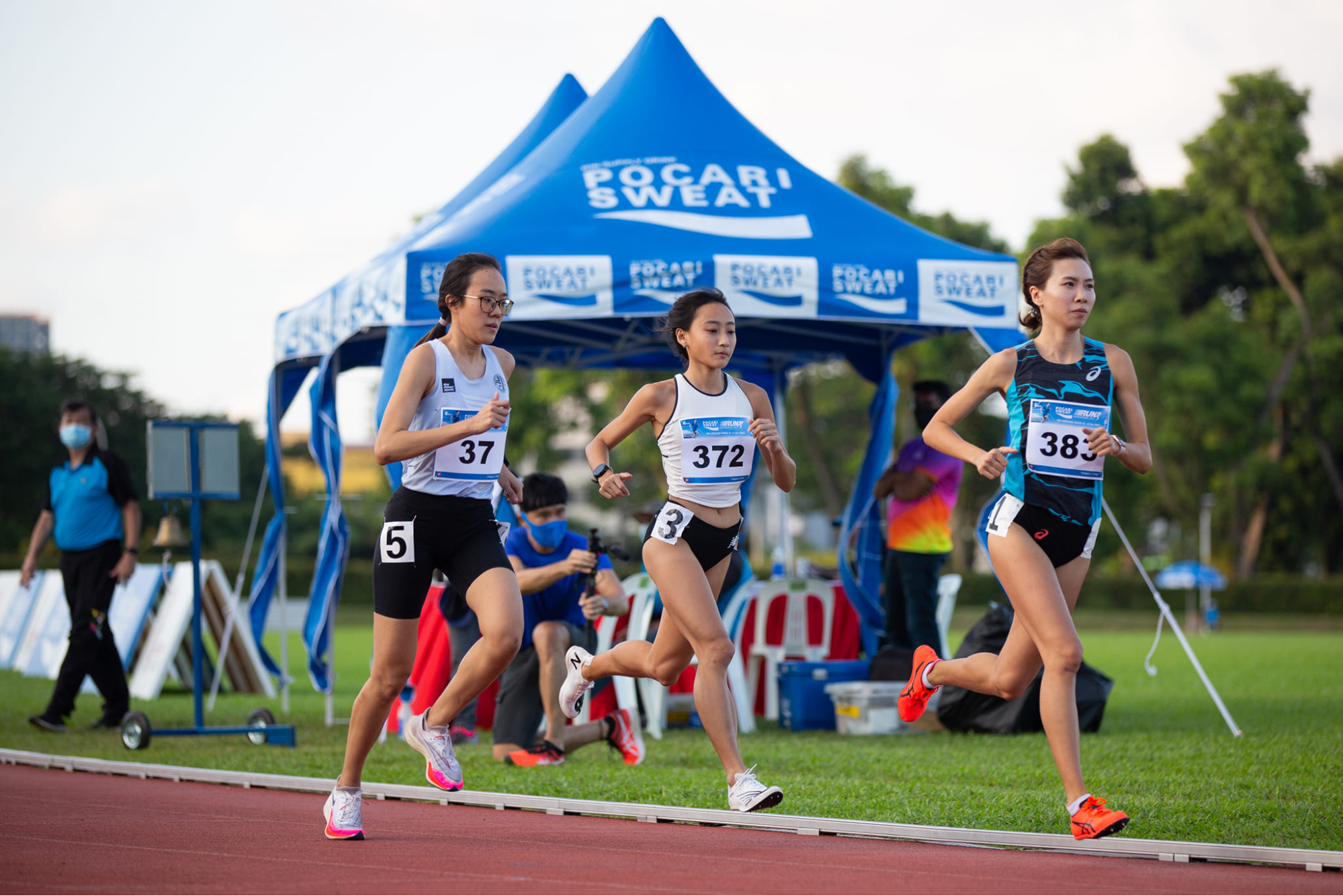 Goh (right) racing her way to a sub-8 minute timing at the Pocari Sweat Run 2021. Photo via Pocari Sweat Singapore.
Goh (right) racing her way to a sub-8 minute timing at the Pocari Sweat Run 2021. Photo via Pocari Sweat Singapore.
Echoing Goh’s sentiments, Jeevaneesh suggests that interval training is a better way to train for a 2.4km race.
“You don’t have to run six laps continuously for training,” he says. “You can do one lap, have a one-minute recovery [time], and then do the next lap, one-minute recovery [and so on].”
“This allows you to practice the pace that you want to run for 2.4km, but you break it down so at least you can achieve it… and then you progressively build yourself up.”
A progressive build-up might start with six intervals of 400m each, with a rest in between, and then progress to five intervals of 500m, four intervals of 600m, and so on.
“So the total distance is close to the 2.4km, but you break it down. I think that will be much more helpful in terms of getting to the full effort.”
3. “‘Just-in-time’ training for 2.4km is good enough, a few weeks to one month before your run.”
Goh explains why “just-in-time” training for the 2.4km run is not sufficient:
“A basic general misconception that people have is that 2.4km is an endurance event. But actually, I really don't agree, I think it's relatively speedy, [and] if you're talking about training your speed, you can’t train it within a month.”
This goes back to how the 2.4km run tests both aerobic and anaerobic capacity.
“Aerobic [capacity] is a bit easier to get. Being able to clock your distance, being able to work your lungs and your lung capacity, that is much easier to get,” says Goh.
Goh points to strength training and plyometric training (“training a muscle to transfer the strength it has for the activity at hand”, explains Goh) as necessary to improve one’s speed.
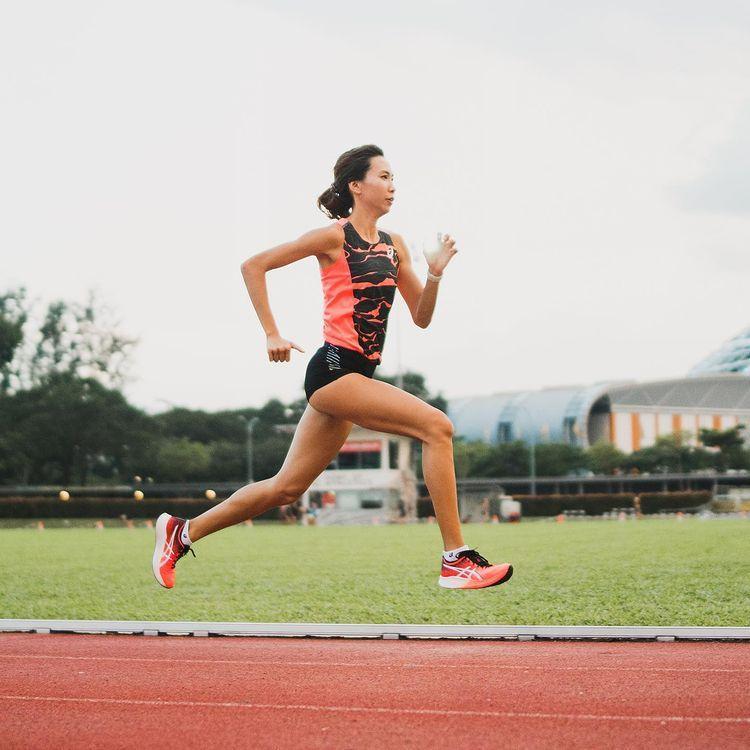 Goh mid-stride. Photo via Goh (@gohchuiling) on Instagram.
Goh mid-stride. Photo via Goh (@gohchuiling) on Instagram.
“Strength, endurance, speed, our foundation exercises and our running technique; it all comes into play,” she says.
Jeevaneesh recommends getting started on training at least two months ahead of the race, with interval training.
This allows for time to reduce the intensity of training leading up to the race, or “taper down”, to give the body time to rest for the final push during the race itself, says Jeevaneesh.
“You can’t expect yourself to run something fast when you didn't really prepare for it progressively,” he says matter-of-factly.
4. “Muscle aches are a sure sign that you pushed hard and trained well”
“Some people who have been very dormant for a long time, no matter what you do, you'll ache, right?” says Goh with a laugh. “So I won’t actually say that you trained well, or hard,”
“It’s your body adapting,” she explains, as muscle aches generally indicate that one’s muscle fibres have torn after intense exertion.
Here, Goh points out that proper nutrition and hydration are key.
“If you trained hard and trained well, but you eat and drink enough, you shouldn't be aching.”
Sufficient protein and carbohydrates after a tough workout will help to reduce aches the day after, Goh says.
She points out that isotonic drinks contain carbohydrates (from their sugar content) and electrolytes.
“These are what makes them really good supplements to have in training, and before and after training,” she adds.
Jeevaneesh also points to the importance of recovery to help manage muscle aches.
“In terms of performance and recovery, hydration is one important aspect,” he says. “For me, I drink Pocari Sweat during and after my training.”
He explains that it contains a balance of electrolytes that closely resembles body fluid, and that this helps to hydrate the body faster than water.
“At the same time, it quenches my thirst and tastes great!” he says.
Along with hydration, Jeevaneesh also does regular foam rolling and stretching as part of his recovery from training.
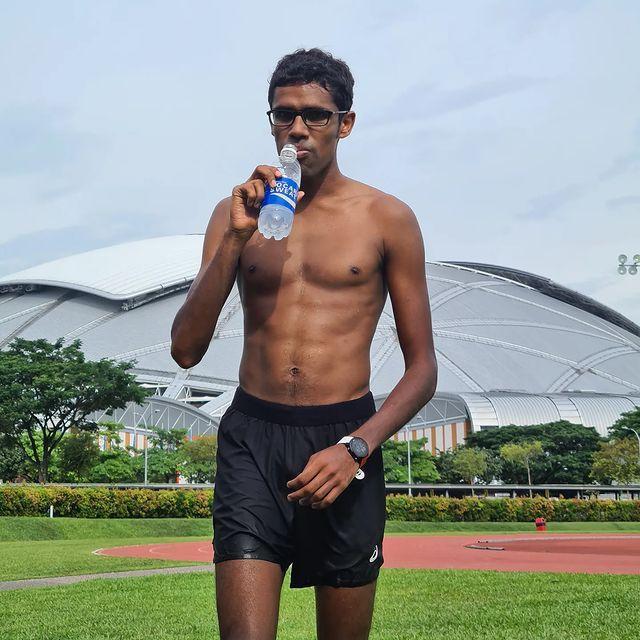 Jeevaneesh during training. Photo via Jeevaneesh (@gunnerjee) on Instagram.
Jeevaneesh during training. Photo via Jeevaneesh (@gunnerjee) on Instagram.
Therefore, because aches can also come about if one does not recover well, one should not use the intensity of muscle aches to gauge how hard they have worked.
Instead, Goh suggests looking at one’s run timings, or other metrics like VO₂ Max (a measure of one’s aerobic capacity) and heart rate variability (used to measure one’s physical fatigue), which can be tracked with devices like smartwatches.
Staying disciplined and motivated
Goh is currently pursuing a PhD in Sports Law, while Jeevaneesh is on a Master’s programme at the University of Melbourne, and both have previously experienced holding down full-time jobs while training competitively.
They are all too familiar with being simply exhausted from the demands of the work day.
“In the worst case scenario where I want to go train, but then I have to do something important, that’s where I learned how to adapt,” says Jeevaneesh.
Besides knowing when and how to adjust one’s training schedule, he suggests that having a group of friends to run with will be helpful, both in terms of motivation, and sharing their knowledge and experience.
Goh also shared how she stays motivated:
“Sports has become a very serious hobby, and almost like a lifestyle. So even if you're super exhausted, you're always thinking, ‘Okay, how do I find more energy to get up?’
This can come with an extra cup of coffee in the afternoon, or having an extra drink, a fruit, or something sweet like a smoothie, so that you’ll wake up for your session, or taking a nap so that I can go for a session.
So you’re always trying hard to find the energy, no matter how tired you are.”
Pocari Sweat Run 2022
Both Goh and Jeevaneesh will be racing at the 2022 edition of the Pocari Sweat Run, which will take place over the entire month of August with both physical and virtual components.
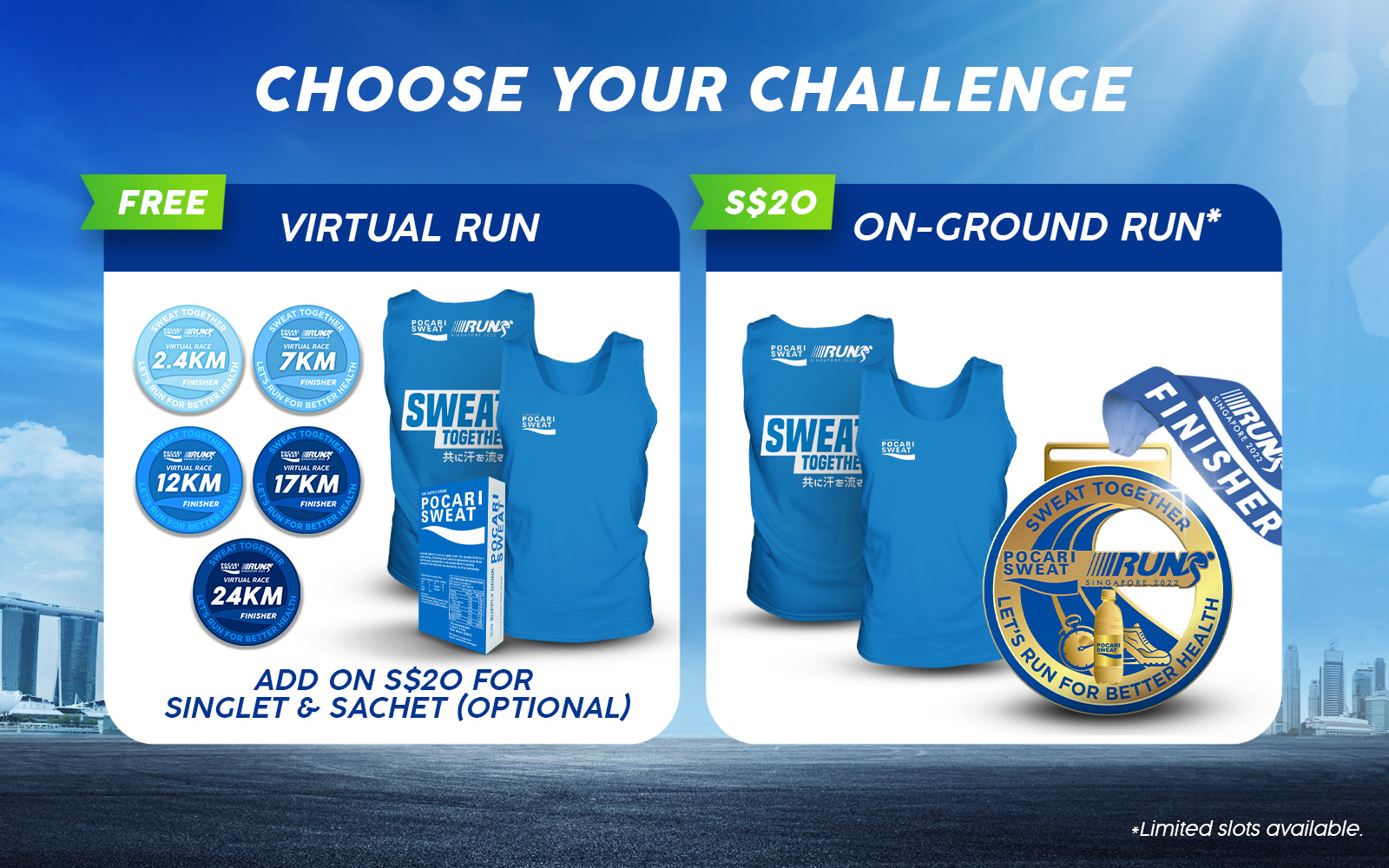
On Ground Run: S$9,000 Prize Pool
For the On-Ground Run, a physical event held on Aug. 20 and 21, top male and female runners from Pocari’s selection trials will join the current record holders to push the limits of 2.4km running in Singapore.
Jeevaneesh’s goal for the 2.4km race is “to do better than the record”, while Goh has a specific target in mind: To go under 7 minutes and 50 seconds.
Thanks to the event’s sponsors, the total prize pool for the event stands at S$9,000 — S$3,800 for the Elite Male category, and S$5,200 for the Elite Female category.
The record-breaking effort will be streamed live on Pocari Sweat’s Facebook page on Aug. 20 (Saturday), with the Elite Female category at 8:15pm and the Elite Male category at 8:30pm.
Members of the public who also want to challenge their own personal best time can sign up for the On Ground Run (S$20), and will receive a goodie bag which includes the official event singlet and a finisher medal.
They will also be able to attempt the Singaporean Male Under 7-minute challenge (Cash prize pool S$1,500) and Singaporean Female Under 8-minute challenge (Cash prize pool S$2,800).
Running for health
The Pocari Sweat Run 2022 aims to promote better health through running and sweating together.
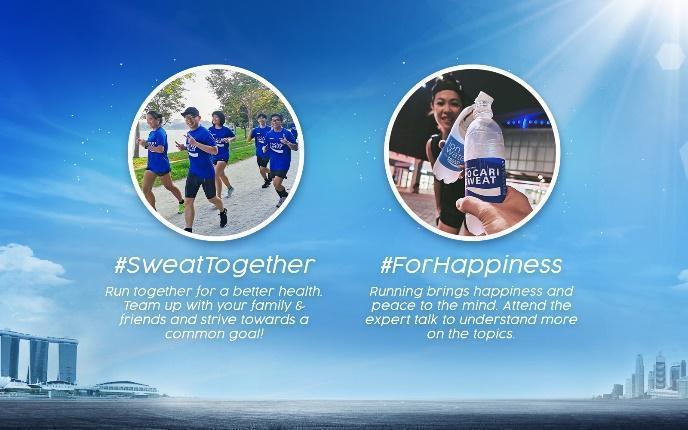
The event is organised by Otsuka Pharmaceuticals (Singapore), with Singapore Athletics as their event partner.
The free virtual race, held over the entire month of August 2022, offers participants their preferred choice of five different distances: 2.4km, 7km, 12km, 17km, and 24km.
Based on the total distance clocked by participants in the virtual component of the run, Otsuka Pharmaceuticals (Singapore) will be donating up to S$2,000 to Silver Ribbon (Singapore), a non-profit organisation that promotes mental health in the community.
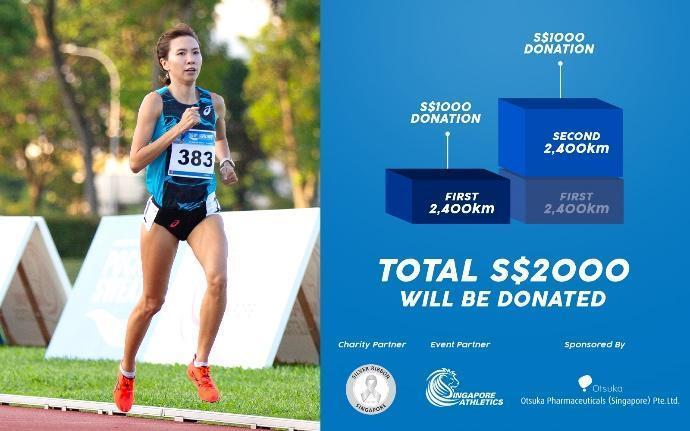
The event also features a webinar on exercise and wellbeing streamed live on Pocari Sweat’s Facebook page on Saturday, Aug. 6, at 10am.
Find out more here.
This sponsored article by Pocari Sweat Singapore made this writer feel motivated to run more.
Top image via Pocari Sweat Singapore.
If you like what you read, follow us on Facebook, Instagram, Twitter and Telegram to get the latest updates.
